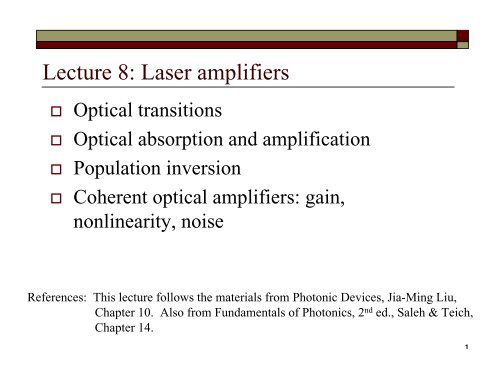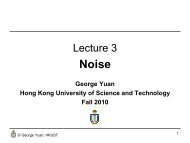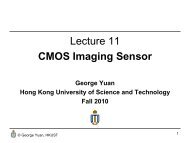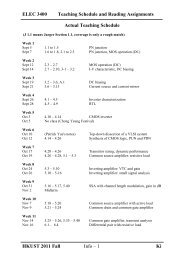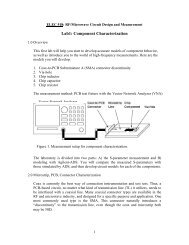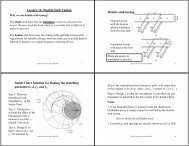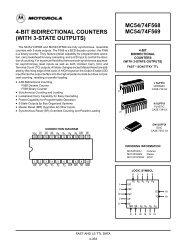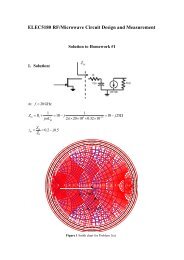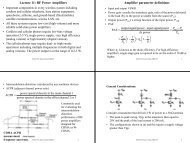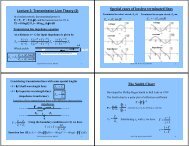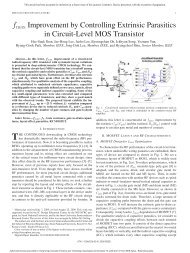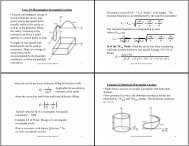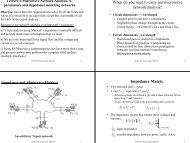Lecture 8: Laser amplifiers
Lecture 8: Laser amplifiers
Lecture 8: Laser amplifiers
You also want an ePaper? Increase the reach of your titles
YUMPU automatically turns print PDFs into web optimized ePapers that Google loves.
<strong>Lecture</strong> 8: <strong>Laser</strong> <strong>amplifiers</strong><br />
<br />
<br />
<br />
<br />
Optical transitions<br />
Optical absorption and amplification<br />
Population inversion<br />
Coherent optical <strong>amplifiers</strong>: gain,<br />
nonlinearity, noise<br />
References: This lecture follows the materials from Photonic Devices, Jia-Ming Liu,<br />
Chapter 10. Also from Fundamentals of Photonics, 2 nd ed., Saleh & Teich,<br />
Chapter 14.<br />
1
Intro<br />
<br />
<br />
<br />
<br />
<br />
<br />
The word laser is an acronym for light amplification by stimulated<br />
emission of radiation.<br />
However, the term laser generally refers to a laser oscillator, which<br />
generates laser light without an input light wave.<br />
A device that amplifies a laser beam by stimulated emission is called a<br />
laser amplifier.<br />
<strong>Laser</strong> light is generally highly collimated with a very small divergence<br />
and highly coherent in time and space. It also has a relatively narrow<br />
spectral linewidth and a high intensity in comparison with light generated<br />
from ordinary sources (e.g. light-emitting diodes)<br />
Due to the process of stimulated emission, an optical wave amplified by a<br />
laser amplifier preserves most of the characteristics including the<br />
frequency spectrum, the coherence, the polarization, the divergence and<br />
the direction of propagation of the input wave.<br />
Here, we discuss the characteristics of laser <strong>amplifiers</strong>. We will discuss<br />
laser oscillators in <strong>Lecture</strong> 9.<br />
2
Optical transitions<br />
3
Optical transitions<br />
<br />
<br />
<br />
Optical absorption and emission occur through the<br />
interaction of optical radiation with electrons in a material<br />
system that defines the energy levels of the electrons.<br />
Depending on the properties of a given material, electrons<br />
that interact with optical radiation can be either those<br />
bound to individual atoms or those residing in the energyband<br />
structures of a material such as a semiconductor.<br />
The absorption or emission of a photon by an electron is<br />
associated with a resonant transition of the electron<br />
between a lower energy level |1> of energy E 1 and an<br />
upper energy level |2> of energy E 2 .<br />
4
Photon-matter interaction processes<br />
There are three fundamental processes electrons make transitions<br />
between two energy levels upon a photon of energy.<br />
E = h 12 = E 2 – E 1<br />
• A two-level system is a model system that only contains<br />
two energy levels with which the photon interacts.<br />
5
Three basic photon-matter interaction processes<br />
<br />
Absorption – when the quantum energy h equals the energy<br />
difference between the two energy levels (a resonant<br />
condition); the atom gains a quantum of energy<br />
<br />
<br />
Stimulated emission – the emission of a photon is triggered<br />
by the arrival of another, resonant photon<br />
Spontaneous emission – when an atom emits a photon,<br />
losing a quantum of energy in the process<br />
<br />
<br />
Einstein in 1917 first pointed out that stimulated emission is<br />
essential in the overall balance between emission and<br />
absorption, about reaching thermal equilibrium for a system<br />
of atoms. (Einstein Relations)<br />
Stimulated emission was demonstrated in 1953 in the<br />
microwave frequency by Basov, Prokhorov and Townes<br />
(Nobel 1964)<br />
6
Three basic photon-matter interaction processes<br />
<br />
<br />
<br />
<br />
A photon emitted by stimulated emission has the same<br />
frequency, phase, polarization and propagation direction as<br />
the optical radiation that induces the process.<br />
Spontaneously emitted photons are random in phase and<br />
polarization and are emitted in all directions, though their<br />
frequencies are still dictated by the separation between the<br />
two energy levels, subject to a degree of uncertainty<br />
determined by the linewidth of the transition.<br />
Therefore, stimulated emission results in the amplification<br />
of an optical signal, whereas spontaneous emission adds<br />
noise to an optical signal.<br />
Absorption leads to the attenuation of an optical signal.<br />
7
Spontaneous emission<br />
An electron spontaneously falls from a higher energy level E 2<br />
to a lower one E 1 , the emitted photon has frequency<br />
= (E 2 –E 1 ) / h<br />
|2><br />
<br />
<br />
This photon is emitted in a random direction with arbitrary<br />
polarization.<br />
The probability of such a spontaneous jump is given<br />
quantitatively by the Einstein coefficient for spontaneous<br />
emission (known as the “Einstein A coefficient”) defined as<br />
|1><br />
A 21 = “probability” per second of a spontaneous jump from<br />
level |2> to level |1>.<br />
8<br />
8
Probability per second of a spontaneous emission<br />
<br />
<br />
For example, if there are N 2 population per unit volume in<br />
level |2> then N 2 A 21 per second make jumps to level |1>.<br />
The total rate at which jumps are made between the two<br />
levels is<br />
dN 2 /dt = -N 2 A 21<br />
A negative sign because the population<br />
of level 2 is decreasing<br />
<br />
Generally an electron can make jumps to more than one lower<br />
level, unless it is in the first (lowest) excited level.<br />
9<br />
9
Natural lifetime<br />
<br />
The population of level |2> falls exponentially with time as<br />
electrons leave by spontaneous emission.<br />
N 2 = N 20 exp(-A 21 t)<br />
<br />
The time in which the population falls to 1/e of its initial<br />
value is called the natural lifetime of level |2>,<br />
2 = 1/A 21<br />
<br />
The magnitude of this lifetime is determined by the actual<br />
probabilities of jumps from level |2> by spontaneous<br />
emission.<br />
10<br />
10
Spectral lineshape<br />
<br />
<br />
<br />
<br />
<br />
The spectral characteristic of a resonant transition is therefore<br />
never infinitely sharp.<br />
Any allowed resonant transition between two energy levels<br />
has a finite relaxation time constant because at least the<br />
upper level has a finite lifetime due to spontaneous emission.<br />
From Quantum Mechanics, the finite spectral width of a<br />
resonant transition is dictated by the uncertainty principle of<br />
quantum mechanics.<br />
Intuitively, any response that has a finite relaxation time in<br />
the time domain must have a finite spectral width in the<br />
frequency domain. (recall the impulse response discussed in<br />
<strong>Lecture</strong> 2)<br />
We will see that the rate of the induced transitions between<br />
two energy levels in a given system is directly proportional to<br />
the spontaneous emission rate from the upper to the lower<br />
level.<br />
11
Spectral lineshape<br />
<br />
<br />
For each particular resonant transition between two energy<br />
levels, there is a characteristic lineshape function g()<br />
^<br />
of<br />
finite linewidth that characterizes the optical processes<br />
associated with the transition.<br />
The lineshape function is generally normalized as<br />
<br />
ĝ() d ĝ() d 1<br />
0<br />
<br />
<br />
0<br />
ĝ() 2ĝ()<br />
Area = 1<br />
<br />
<br />
<br />
12<br />
12
Homogeneous broadening<br />
<br />
<br />
<br />
<br />
If all of the atoms in a material that participate in a resonant<br />
interaction associated with the energy levels |1> and |2> are<br />
indistinguishable, their responses to an electromagnetic field<br />
are characterized by the same resonance frequency 21 and<br />
the same relaxation constant 21 .<br />
In such a homogeneous system, the physical mechanisms that<br />
contribute to the linewidth of the transition affect all atoms<br />
equally.<br />
Spectral broadening due to such mechanisms is called<br />
homogeneous broadening.<br />
Previously (in Lect. 2), we discussed that such<br />
homogeneously broadened systems can be described as the<br />
damped response characterized by a single resonance<br />
13<br />
frequency and a single relaxation constant.
Homogeneous broadening<br />
<br />
<br />
<br />
In the interaction of a material with an optical field, the<br />
absorption and emission of optical energy are characterized<br />
by the imaginary part ” of the susceptibility of the material.<br />
Therefore, the spectral characteristics of optical absorption<br />
and emission due to a resonant transition in a homogeneously<br />
broadened medium are described by the Lorentzian lineshape<br />
function of ”(). (recall from Lect 2)<br />
Using the normalization condition, we find that the resonant<br />
transition between |1> and |2> has the following normalized<br />
Lorentzian lineshape function:<br />
ĝ() <br />
h<br />
2[( 21<br />
) 2 ( h<br />
/2) 2 ]<br />
where h is the FWHM of the lineshape<br />
14
Inhomogeneous broadening<br />
<br />
<br />
<br />
<br />
However, in many practical situations, the simple picture that<br />
gives rise to Lorentzian lineshape is not adequate.<br />
For example, because of the Doppler effect, gas atoms with<br />
different velocities have different effective resonance<br />
frequencies even if they are otherwise identical.<br />
In solids the slightly different environments in which the<br />
resonant atoms find themselves, such as random dislocations,<br />
impurities and strain fields, also give rise to different<br />
effective resonance frequencies for differently located but<br />
otherwise identical atoms.<br />
Thus, in many cases the actual emission line must be thought<br />
of as a superposition of a large number of Lorentzian lines,<br />
each with homogeneous width k and each with a distinct<br />
center frequency k .<br />
Ref: Optical resonance and two-level atoms, L. Allen and J. H. Eberly, pp. 7-10<br />
15
Spectral lineshape<br />
Spread in<br />
frequencies<br />
Gaussian lineshape<br />
<br />
<br />
<br />
The origin of inhomogeneous broadening. The individual Lorentzian<br />
emission lines associated with different atomic dipoles are oscillating at<br />
multiple distinct frequencies.<br />
If a dielectric material is made up of those atoms with such individual<br />
lines, its emission line will be the sum of the curves. When the individual<br />
lines are densely spaced over a frequency range large compared with their<br />
own individual widths, the total lineshape is termed inhomogeneously<br />
broadened.<br />
<br />
Ref: Optical resonance and two-level atoms, L. Allen and J. H. Eberly, pp. 7-10<br />
16
Transition rates<br />
<br />
<br />
<br />
<br />
<br />
<br />
The transition rate of a resonant optical process measures the<br />
probability per unit time for the process to occur.<br />
The transition rate of an induced process is a function of the<br />
spectral distribution of the optical radiation and the spectral<br />
characteristics of the resonant transition.<br />
The spectral distribution of an optical field is characterized by<br />
its spectral energy density u() – the energy density of the<br />
optical radiation per unit frequency interval at the optical<br />
frequency .<br />
The total energy density of the radiation<br />
The spectral intensity distribution I() = (c/n) u(), n is the<br />
refractive index of the medium<br />
The total intensity<br />
I <br />
<br />
<br />
0<br />
I()d<br />
u <br />
<br />
<br />
0<br />
u()d<br />
17
Spectral energy density<br />
<br />
<br />
The energy density of a radiation field u() (joules per unit<br />
volume per unit frequency interval) can be simply related to<br />
the intensity of a plane electromagnetic wave.<br />
If the intensity of the wave is I() (watts per unit area per<br />
frequency interval)<br />
u() c = I()<br />
where c is the velocity of light in free space (in the medium<br />
of refractive index n, u() c/n = I())<br />
V<br />
A<br />
Length c in a second<br />
18<br />
18
Transition rates<br />
<br />
For the upward transition from |1> to |2> associated with<br />
absorption in the frequency range between and +d is<br />
W 12<br />
()d B 12<br />
u()ĝ()d<br />
(s -1 )<br />
<br />
For the downward transition from |2> to |1> associated with<br />
stimulated emission<br />
W 21<br />
()d B 21<br />
u()ĝ()d<br />
(s -1 )<br />
<br />
The spontaneous emission rate is independent of the energy<br />
density of the radiation and is solely determined by the<br />
transition lineshape function<br />
W sp<br />
()d A 21 ĝ()d<br />
(s -1 )<br />
The A and B constants are the Einstein A and B coefficients.<br />
19
Radiative processes connecting two energy levels in<br />
thermal equilibrium<br />
Population N 2<br />
E 2<br />
Spontaneous<br />
emission<br />
Stimulated<br />
emission<br />
absorption<br />
h<br />
Population N 1<br />
<br />
Einstein (1917) demonstrated that the rates of the three<br />
transition processes of absorption (B 12 ), stimulated emission<br />
(B 21 ) and spontaneous emission (A 21 ) are related.<br />
E 1<br />
20<br />
20
Transition rates<br />
<br />
<br />
The total induced transition rates<br />
W 12<br />
<br />
W 21<br />
<br />
<br />
W 12<br />
()d B 12<br />
u()ĝ()d<br />
0<br />
<br />
<br />
<br />
0<br />
W 21<br />
()d B 21<br />
u()ĝ()d<br />
0<br />
<br />
<br />
0<br />
The total spontaneous emission rate is<br />
W sp<br />
<br />
<br />
<br />
0<br />
W sp<br />
()d A 21<br />
u()<br />
W 12<br />
= B 12<br />
u()<br />
N 2<br />
|2><br />
W 21<br />
= B 21<br />
u() W sp<br />
= A 21<br />
|1><br />
N 1<br />
21
Transition rates<br />
<br />
<br />
<br />
The induced and the spontaneous transition rates for a given<br />
system are directly proportional to one another.<br />
The relationship can be obtained by considering the<br />
interaction of blackbody radiation with an ensemble of<br />
identical atomic systems in thermal equilibrium.<br />
The spectral energy density of the blackbody radiation at a<br />
temperature T (known as thermal radiation or blackbody<br />
radiation) is given by Planck’s formula:<br />
u() 8n3 h 3<br />
c 3 1<br />
e h /k BT 1<br />
where k B is the Boltzmann constant, k B T is the thermal<br />
energy (k B T = 26 meV @ T = 300 K)<br />
22
Blackbody radiation<br />
<br />
<br />
<br />
A system under thermal equilibrium produces a radiation<br />
energy density u()(J Hz -1 m -3 ) which is identical to<br />
blackbody radiation.<br />
A blackbody absorbs 100% all the radiation falling on it,<br />
irrespective of the radiation frequency.<br />
If the inside of this body is in thermal equilibrium it must<br />
radiate as much energy as it absorbs and the emission from<br />
the body is therefore characteristic of the equilibrium<br />
temperature T inside the body<br />
=> this type of radiation is often called “thermal” radiation or<br />
blackbody radiation<br />
Thermal<br />
radiation<br />
23<br />
23
Planck’s law of blackbody radiation<br />
<br />
Planck showed that the radiation energy density for a<br />
blackbody radiating within a frequency range to +d is given<br />
by<br />
u = (8n h 3 /c 3 ) [exp(h/k B T) – 1] -1<br />
= (8n 2 /c 3 ) h [exp(h/k B T) – 1] -1<br />
Photon energy<br />
Photon density of states in a medium<br />
Of refractive index n<br />
(number of photon modes per<br />
volume per frequency interval)<br />
Photon probability of occupancy<br />
(average number of photons in each<br />
mode according to Bose‐Einstein<br />
distribution)<br />
24<br />
24
Planck’s law of blackbody radiation<br />
180<br />
Radiation energy density u() (JHz ‐1 m ‐3 )<br />
160<br />
140<br />
120<br />
100<br />
80<br />
60<br />
40<br />
20<br />
0<br />
1500 K<br />
1000 K<br />
0 5E+13 1E+14 1.5E+14 2E+14 2.5E+14 3E+14 3.5E+14<br />
Frequency (Hz)<br />
25<br />
25
Transition rates<br />
<br />
If N 2 and N 1 are the population densities per unit volume of<br />
the atoms in levels |2> and |1>, the number of atoms per unit<br />
volume making the downward transition per unit time<br />
accompanied by the emission of radiation in a frequency<br />
range from to +d<br />
N 2<br />
(W 21<br />
()W sp<br />
())d<br />
<br />
The number of atoms per unit volume making the upward<br />
transition per unit time<br />
N 1<br />
W 12<br />
()d<br />
26
Transition rates<br />
<br />
In thermal equilibrium, both the blackbody radiation spectral<br />
density and the atomic population density in each energy<br />
level should reach a steady state<br />
N 2<br />
(W 21<br />
()W sp<br />
()) N 1<br />
W 12<br />
()<br />
<br />
This is the principle of detailed balance in thermal<br />
equilibrium. The steady-state population distribution in<br />
thermal equilibrium:<br />
N 2<br />
N 1<br />
<br />
W 12<br />
()<br />
W 21<br />
()W sp<br />
() <br />
B 12<br />
u()<br />
B 21<br />
u() A 21<br />
27
Transition rates<br />
<br />
In thermal equilibrium at temperature T, the population ratio<br />
of the atoms in the upper and the lower levels follows the<br />
Boltzmann distribution.<br />
N 2<br />
N 1<br />
g 2<br />
g 1<br />
exp(h / k B<br />
T )<br />
where g 2 and g 1 are the degeneracy factors* of these energy<br />
levels, and the energy density<br />
u() <br />
A 21<br />
/ B 21<br />
g 1<br />
B 12<br />
<br />
exp(h / k B<br />
T)1<br />
g 2<br />
B 21 <br />
*In an atomic or molecular system, a given energy level<br />
usually consists of a number of degenerate quantummechanical<br />
states, which have the same energy.<br />
28
Boltzmann distribution<br />
Energy E<br />
E 2<br />
N 2
Transition rates<br />
Identify u() with Planck’s formula:<br />
A 21<br />
8n3 h 3<br />
B 21<br />
c 3<br />
g 1<br />
B 12<br />
g 2<br />
B 21<br />
The spontaneous radiative lifetime of the atoms in the level |2><br />
associated with the radiative spontaneous transition from |2> to<br />
|1> is<br />
sp<br />
1 1<br />
W sp<br />
A 21<br />
30
Transition rates<br />
<br />
<br />
Therefore, the spectral dependence of the spontaneous<br />
emission rate<br />
W sp<br />
() 1 ĝ()<br />
sp<br />
The transition rates of both of the induced processes of<br />
absorption and stimulated emission are directly proportional<br />
to the spontaneous emission rate.<br />
W 21<br />
() <br />
c 3<br />
8n 3 h 3 sp<br />
u()ĝ() <br />
c 2<br />
8n 2 h 3 sp<br />
I()ĝ()<br />
W 12<br />
() g 2<br />
g 1<br />
W 21<br />
()<br />
31
Transition cross section<br />
We often express the transition probability of an atom in its<br />
interaction with optical radiation at a frequency in terms of the<br />
transition cross section, () [m 2 , cm 2 ].<br />
W 21<br />
() I()<br />
h 21 ()<br />
W 12<br />
() I()<br />
h 12 ()<br />
hphoton-flux<br />
density)<br />
The emission cross section<br />
e<br />
() 21<br />
() <br />
c 2<br />
8n 2 2 sp<br />
ĝ()<br />
The absorption cross section<br />
a<br />
() 12<br />
() g 2<br />
g 1<br />
21<br />
() g 2<br />
g 1<br />
e<br />
()<br />
32
Transition cross section<br />
<br />
<br />
<br />
For the ideal Lorentzian lineshape in a homogeneously<br />
broadened medium<br />
ĝ() <br />
h<br />
2[( 21<br />
) 2 ( h<br />
/2) 2 ]<br />
The peak value of the lineshape occurs at the center of the<br />
spectrum and is a function of linewidth h only.<br />
2<br />
gˆ ( <br />
21)<br />
<br />
<br />
Thus, the peak value of the emission cross section at the<br />
center wavelength of the spectrum<br />
<br />
e<br />
h<br />
h<br />
2<br />
<br />
2<br />
4<br />
n <br />
<br />
2<br />
sp<br />
33
Characteristics of some laser materials<br />
Gain medium<br />
Wavelength<br />
(m)<br />
System<br />
Peak cross<br />
section e<br />
(m 2 )<br />
Spontaneous<br />
linewidth<br />
(gain<br />
bandwidth)<br />
<br />
sp<br />
2<br />
HeNe 0.6328 I, 4 3.0x10 -17 1.5 GHz 300 ns 30 ns<br />
Ruby (Cr 3+ :Al 2<br />
O 3<br />
) 0.6943 H, 3 1.25-2.5 x<br />
10 -24 330 GHz 3 ms 3 ms<br />
Nd:YAG 1.064 H, 4 2-10 x 10 -23 150 GHz 515 s 240 s<br />
Nd:glass 1.054 I, 4 4.0 x 10 -24 6 THz 330 s 330 s<br />
Er:fiber 1.53 H/I, 3 6.0 x 10 -25 5 THz 10 ms 10 ms<br />
Ti:sapphire 0.66-1.1 H,Q2 3.4x10 -23 100 THz 3.9 s 3.2 s<br />
Semiconductor 0.37-1.65 H/I, Q2 1-5 x 10 -20 10-20 THz ~1 ns ~1 ns<br />
H: homogeneously broadened; I: inhomogeneously broadened<br />
34<br />
34
Optical absorption and<br />
amplification<br />
35
Optical absorption and amplification<br />
For a monochromatic optical field at frequency and intensity<br />
I() = I(’-)<br />
W 21 = (I/h) e () and W 12 = (I/h) a ()<br />
<br />
The net power (time-averaged) that is transferred from the optical<br />
field to the material is the difference between that absorbed by the<br />
material and that emitted due to stimulated emission:<br />
W p = hW 12 N 1 –hW 21 N 2<br />
= [N 1 a () – N 2 e ()]I<br />
<br />
<br />
W p > 0 => net power absorption from the optical field<br />
W p < 0 => net power flows from the medium to the optical field<br />
36
Optical absorption and amplification<br />
absorption coefficient [m -1 , cm -1 ]<br />
() = N 1 a () – N 2 e () = (N 1 –(g 1 /g 2 )N 2 ) a ()<br />
gain coefficient [m -1 , cm -1 ]<br />
() = N 2 e () – N 1 a () = (N 2 –(g 2 /g 1 )N 1 ) e ()<br />
() > 0 and () < 0 if N 1 > (g 1 /g 2 ) N 2<br />
() > 0 and () < 0 if N 2 > (g 2 /g 1 ) N 1<br />
<br />
<br />
A material absorbs optical energy in its normal state of thermal<br />
equilibrium when the lower energy level is more populated than the upper<br />
energy level.<br />
A material must be in a nonequilibrium state of population inversion with<br />
the upper energy level more populated than the lower energy level in<br />
order to provide a net optical gain to the optical field. 37
Optical absorption and amplification<br />
For simplicity, in some later discussion we can assume the<br />
degeneracy of levels 1 and 2 are equal, i.e. g 1 = g 2<br />
absorption coefficient [m -1 , cm -1 ]<br />
() = N 1 a () – N 2 e () = (N 1 –N 2 ) ()<br />
gain coefficient [m -1 , cm -1 ]<br />
() = N 2 e () – N 1 a () = (N 2 –N 1 ) ()<br />
() > 0 and () < 0 if N 1 > N 2<br />
() > 0 and () < 0 if N 2 > N 1<br />
And e () = a () = ()<br />
38
Resonant optical susceptibility<br />
<br />
For resonant interaction of an isotropic medium with a<br />
monochromatic plane optical field at a frequency = 2,<br />
we have<br />
E(t) Ee it E *e it<br />
P r es<br />
(t) 0<br />
( res<br />
()Ee it * res()E *e it )<br />
<br />
where P res is the polarization contributed by the resonant<br />
transitions and res is the resonant susceptibility.<br />
The time-averaged power density absorbed by the medium is<br />
P<br />
2 <br />
W<br />
p<br />
E 2<br />
0"<br />
res<br />
( )<br />
| E | "<br />
res<br />
( )<br />
I<br />
t<br />
nc<br />
t<br />
39
Resonant optical susceptibility<br />
<br />
<br />
<br />
<br />
<br />
Relate the time-averaged power density absorbed by the<br />
medium to the population relation<br />
<br />
W<br />
p<br />
" res<br />
( )<br />
I [ N1<br />
a<br />
( )<br />
N<br />
2<br />
e<br />
( )]<br />
I<br />
nc<br />
The imaginary part of the susceptibility contributed by the<br />
resonant transitions between energy levels |1> and |2> is<br />
" res<br />
() nc<br />
[N 1 a<br />
() N 2<br />
e<br />
()]<br />
The real part ’ res () can then be found through the Kramers-<br />
Kronig relations (recall from Lect. 2)<br />
Recall from Lect. 2 that a medium has an optical loss if ”><br />
0, and it has an optical gain if ”< 0.<br />
It is also clear that there is a net power loss from the optical<br />
field to the medium if ” res > 0, but there is a net power gain<br />
for the optical field if ” res < 0.<br />
40
Resonant optical susceptibility<br />
<br />
The medium has an absorption coefficient given by<br />
() nc " () res<br />
<br />
( )<br />
"<br />
( )<br />
in the case of normal population distribution when ” res >0,<br />
whereas it has a gain coefficient given by<br />
<br />
nc<br />
In the case of population inversion when ” res
Resonant optical susceptibility<br />
<br />
When the phase information of the optical wave is of no<br />
interest, we can find the evolution of the intensity of the<br />
optical wave as it propagates through the medium.<br />
dI/dz = -I<br />
(-ve sign represents attenuation)<br />
in the case of optical attenuation when ” res > 0, and<br />
dI/dz = I<br />
in the case of optical amplification when ” res < 0<br />
42
Population inversion<br />
43
Population inversion and optical gain<br />
<br />
<br />
<br />
<br />
<br />
Population inversion is the basic condition for the presence of<br />
an optical gain.<br />
In the normal state of any system in thermal equilibrium, a<br />
low-energy state is always more populated than a high-energy<br />
state – no population inversion<br />
Population inversion in a system can only be accomplished<br />
through a process called pumping – actively exciting the<br />
atoms in a low-energy state to a high-energy state.<br />
Population inversion is a nonequilibrium state that cannot be<br />
sustained without active pumping. To maintain a constant<br />
optical gain we need continuous pumping to keep the<br />
population inversion at a constant level.<br />
Many different pumping techniques depending on the gain<br />
media: optical excitation, current injection, electric<br />
discharge, chemical reaction, and excitation with ion beams<br />
44
Population inversion<br />
<br />
A nonequilibrium distribution showing population inversion<br />
Energy E<br />
E 2<br />
E 1<br />
N 1<br />
N 2<br />
Population N<br />
45
Population inversion and optical gain<br />
<br />
<br />
<br />
<br />
The use of a particular pumping technique depends on the<br />
properties of the gain medium being pumped.<br />
The lasers and optical <strong>amplifiers</strong> are often made of either<br />
dielectric solid-state media doped with active ions, such as<br />
Nd:YAG and Er:glass fiber, or direct-gap semiconductors,<br />
such as GaAs and InP.<br />
For dielectric media, the most commonly used pumping<br />
technique is optical pumping either with incoherent light<br />
sources, such as flashlamps and light-emitting diodes, or<br />
with coherent light sources from other lasers.<br />
Semiconductor gain media can also be optically pumped,<br />
but they are usually pumped with electric current<br />
injection.<br />
46
Rate equations<br />
The net rate of change of population density in a given energy<br />
level is described by a rate equation.<br />
Here we only write the rate equations for the upper laser level<br />
|2> and the lower laser level |1>.<br />
In the presence of a monochromatic, coherent optical wave of<br />
intensity I at a frequency ,<br />
dN 2 /dt = R 2 –N 2 / 2 – (I/h) (N 2 e –N 1 a )<br />
dN 1 /dt = R 1 –N 1 / 1 + N 2 / 21 + (I/h) (N 2 e –N 1 a )<br />
where R 2 and R 1 are the total rates of pumping into energy<br />
levels |2> and |1>, and 2 and 1 are the fluorescence lifetimes<br />
(total lifetimes) of levels |2> and |1>. The rate of population<br />
decay, including radiative and nonradiative spontaneous<br />
relaxation from |2> to |1> is 1/ 21 .<br />
47
Rate equations<br />
<br />
Because it is possible for the population in level |2> to relax<br />
to other energy levels, the total population decay rate of level<br />
|2> is 1/ 2 1/ 21 .<br />
2 21 sp<br />
<br />
<br />
<br />
In an optical gain medium, level |2> is known as the upper<br />
laser level and level |1> is known as the lower laser level.<br />
The fluorescence lifetime 2 of the upper laser level is an<br />
important parameter that determines the effectiveness of a<br />
gain medium.<br />
In general, the upper laser level has to be a metastable state<br />
with a relatively large 2 for a gain medium to be useful.<br />
48
Population inversion<br />
<br />
Population inversion in a medium is generally defined as<br />
N 2 > (g 2 /g 1 ) N 1<br />
(N 2 > N 1 for g 1 = g 2 )<br />
<br />
<br />
However, this condition does not guarantee an optical gain at a particular<br />
optical frequency when the population in each level, |1> or |2>, is<br />
distributed unevenly among its sublevels.<br />
A better condition for population inversion to guarantee an optical gain at<br />
a given frequency <br />
N 2 e () – N 1 a () > 0<br />
<br />
The pumping requirement for the condition to be satisfied depends on the<br />
properties of a medium. For atomic and molecular media, there are three<br />
different basic systems. Each has a different pumping requirement to<br />
reach effective population inversion for an optical gain. The pumping<br />
requirement can be found by solving the coupled rate equations.<br />
49
Two-level systems<br />
pump<br />
h p<br />
h<br />
|2><br />
|1><br />
When the only energy levels involved in the pumping and the<br />
relaxation processes are the upper and the lower laser levels<br />
|2> and |1>, the system can be considered as a two-level<br />
system. (i.e. p = )<br />
Level |1> is the ground state with 1 = ∞, and level |2><br />
relaxes only to level |1> so that 21 = 2 .<br />
The total population density is N t = N 1 + N 2 .<br />
50
Two-level systems<br />
<br />
<br />
No matter how a true two-level system is pumped, it is not<br />
possible to achieve population inversion for an optical gain<br />
in the steady state.<br />
The optical pump for a two-level system has to be in<br />
resonance with the transition between the two levels –<br />
inducing both downward and upward transitions.<br />
|2><br />
pump<br />
h p<br />
h p<br />
<br />
While a pumping mechanism excites atoms from the lower<br />
energy level to the upper energy level, the same pump also<br />
stimulates atoms in the upper energy level to relax to the<br />
lower energy level.<br />
|1><br />
51
Two-level systems<br />
<br />
While a pumping mechanism excites atoms from the lower<br />
laser level to the upper laser level, the same pump also<br />
stimulates atoms in the upper laser level to relax to the lower<br />
laser level.<br />
R 2 = -R 1 = W 12p N 1 -W 21p N 2 ,<br />
where W 12p and W 21p are the pumping rates from 1 to 2 and<br />
from 2 to 1.<br />
<br />
<br />
Under these conditions, dN 2 /dt and dN 1 /dt are equivalent to<br />
each other (N 1 + N 2 = N t = constant).<br />
The upward (W 12p ) and downward (W 21p ) pumping rates are<br />
not independent of each other but are directly proportional to<br />
each other because both are associated with the interaction of<br />
the same pump source with a given set of energy levels.<br />
52
Two-level systems<br />
Take the upward pumping rate W 12p = W p and the downward<br />
pumping rate to be W 21P = p W p , where p is a constant that depends<br />
on the detailed characteristics of the two-level atomic system and<br />
the pump source.<br />
In the steady state when dN 2 /dt = dN 1 /dt = 0,<br />
N 2 e –N 1 a = [W p 2 ( e -p a )- a ]N t [1+(1+p)W p 2 + (I 2 /h)( e + a )] -1<br />
<br />
For optical pumping<br />
p = ep / ap = e ( p )/ a ( p ),<br />
where ap and ep are the absorption and emission cross sections at<br />
the pump wavelength.<br />
53
Two-level systems<br />
<br />
<br />
In a true two-level system, the energy levels |2> and |1> can<br />
each be degenerate with degeneracies g 2 and g 1 , but the<br />
population densities in both levels are evenly distributed<br />
among the respective degenerate states.<br />
In this situation, p = ep / ap = g 1 /g 2 = e / a<br />
N 2 e –N 1 a = - a N t [1+( e + a )(I/hW p / a ) 2 ] -1 < 0<br />
<br />
No matter how a true two-level system is pumped, it is clearly<br />
not possible to attain population inversion for an optical gain<br />
in the steady state.<br />
54
Two-level systems<br />
<br />
<br />
Intuitively, the pump for a two-level system has to be in<br />
resonance with the transition between the two levels, thus<br />
inducing downward transitions and upward transitions.<br />
In the steady state, the two-level system would reach thermal<br />
equilibrium with the pump at a finite temperature T, resulting<br />
in a Boltzmann population distribution<br />
N 2 /N 1 = (g 2 /g 1 ) exp(-h/k B T) without population inversion.<br />
55
Quasi-two-level systems<br />
|2><br />
pump<br />
h p<br />
h<br />
|1><br />
<br />
<br />
<br />
However, many laser gain media including laser dyes,<br />
semiconductor gain media, and some solid-state gain media,<br />
are often pumped as a quasi-two-level system.<br />
An energy level is split into a band of closely spaced, but not<br />
exactly degenerate, sublevels with its population density<br />
unevenly distributed among these sublevels.<br />
A system is a quasi-two-level system if either or both of the<br />
two levels involved are split in such a manner.<br />
56
Quasi-two-level systems<br />
<br />
<br />
<br />
By pumping such a quasi-two-level system properly, it is<br />
possible to reach the needed population inversion in the steady<br />
state for an optical gain at a particular laser frequency .<br />
Now the ratio p = ep / ap at the pump frequency p can be<br />
made different from the ratio e / a at the laser frequency due<br />
to the uneven population distribution among the sublevels<br />
within an energy level.<br />
The pumping requirements for a steady-state optical gain from<br />
a quasi-two-level system (see p.53)<br />
p = ep / ap < e / a ; W p > (1/ 2 ) a /( e –p a )<br />
<br />
Because the absorption spectrum is generally shifted to the<br />
short-wavelength side of the emission spectrum, these<br />
conditions can be satisfied by pumping sufficiently strongly at a<br />
higher transition energy than the photon energy corresponding<br />
to the peak of the emission spectrum.<br />
57
Three-level systems<br />
|3><br />
Nonradiative<br />
relaxation<br />
pump<br />
h p<br />
h<br />
|2><br />
|1><br />
<br />
<br />
Population inversion in steady state is possible for a threelevel<br />
system.<br />
The lower laser level |1> is the ground state (or is very close<br />
to the ground state, within an energy separation of above the upper<br />
laser level |2>.<br />
58
Population inversion in three-level systems<br />
Over a period the population in the metastable state N 2<br />
increases above those in the ground state N 1 .<br />
=>The population inversion is obtained between levels |2><br />
and |1>.<br />
<br />
Drawback: the three-level system generally requires very<br />
high pump powers because the terminal state of the<br />
stimulated transition is the ground state. More than half the<br />
ground state atoms must be pumped into the metastable state<br />
to attain population inversion.<br />
59
Three-level systems<br />
<br />
An effective three-level system satisfies the following<br />
conditions:<br />
• Population relaxation from level |3> to level |2> is very<br />
fast and efficient, ideally 2 >> 32 ≈ 3<br />
s. t. the atoms excited by the pump quickly end up in level<br />
|2><br />
• Level |3> lies sufficiently high above level |2> with E 32<br />
>> k B T s. t. the population in level |2> cannot be<br />
thermally excited back to level |3><br />
• The lower laser level |1> is the ground state, or its<br />
population relaxes very slowly if it is not the ground state.<br />
<br />
Under these conditions<br />
R 2 ≈ W p N 1 , R 1 ≈ -W p N 1 , and N 1 +N 2 ≈ N t<br />
1 ≈∞and 21 ≈ 2<br />
60
Three-level systems<br />
The parameter W P is the effective pumping rate for exciting an atom in the<br />
ground state to eventually reach the upper laser level. It is proportional to<br />
the power of the pump.<br />
In the steady state with a constant pump, W p is a constant and dN 2 /dt =<br />
dN 1 /dt = 0<br />
N 2 e –N 1 a = (W p 2 e - a )N t [1+W p 2 + (I 2 /h)( e + a )] -1<br />
<br />
The pumping condition for a constant optical gain under steady-state<br />
population inversion<br />
W p > a / 2 e<br />
<br />
<br />
This condition sets the minimum pumping requirement for effective<br />
population inversion to reach an optical gain in a three-level system.<br />
Note that almost all of the population initially resides in the lower laser<br />
level |1>. To attain population inversion, the pump has to be strong<br />
enough to depopulate sufficient population density from level |1>, while<br />
the system has to be able to keep it in level |2>. In the case when a = e<br />
(i.e. g 1 = g 2 ), no population inversion occurs before at least one-half of<br />
the total population is transferred from level |1> to level |2>.<br />
61
Erbium-doped silica fibers<br />
<br />
Er 3+ :silica fiber amplifier is a three-level system.<br />
3<br />
32<br />
pump<br />
2<br />
1.55 m<br />
• Pumping at 980 nm using InGaAs laser diodes; a mixture of<br />
homogeneous/inhomogeneous broadening; ~ 5.3 THz<br />
1<br />
• The laser transition can also be directly pumped at 1.48 m by<br />
light from InGaAsP laser diodes – like a quasi-two-level scheme<br />
62<br />
62
Four-level systems<br />
pump<br />
h p<br />
Nonradiative<br />
relaxation<br />
Nonradiative<br />
relaxation<br />
h<br />
|3><br />
|2><br />
|1><br />
|0><br />
<br />
<br />
A four-level system is more efficient than a three-level<br />
system.<br />
The lower laser level |1> lies sufficiently high above the<br />
ground level |0>, with E 10 >> k B T. Thus, in thermal<br />
equilibrium, the population in |1> is negligibly small<br />
compared with that in |0>. Pumping takes place from level<br />
|0> to level |3>.<br />
63
Four-level systems<br />
<br />
<br />
<br />
Levels |3> and |2> need to satisfy the same conditions as in a three-level<br />
system.<br />
The population in level |1> relaxes very quickly back to the ground level,<br />
ideally 1 ≈ 10 remains relatively unpopulated in<br />
comparison with level |2> when the system is pumped.<br />
Under these conditions,<br />
N 1 ≈ 0; R 2 ≈ W p (N t –N 2 )<br />
where the effective pumping rate W p is proportional to the pump power.<br />
In the steady state when W p is held constant, by taking dN 2 /dt = 0,<br />
(ignoring dN 1 /dt because N 1 ≈ 0)<br />
N 2 e –N 1 a ≈ N 2 e =(W p 2 e )N t [1 + W p 2 + (I 2 /h) e ] -1<br />
=> No minimum pumping requirement for an ideal four-level system because<br />
level |1> is initially empty. A practical four-level system is much more<br />
efficient than a three-level system.<br />
64
Neodymium-doped glass<br />
<br />
Nd 3+ :glass amplifier is a four-level system.<br />
3<br />
32<br />
pump<br />
0<br />
1<br />
2<br />
1.053 m<br />
1<br />
65<br />
65
Neodymium-doped glass<br />
<br />
Level 1 is 0.24 eV above the ground state. This is substantially<br />
larger than the thermal energy 0.026 eV at room temperature, so<br />
that the thermal population of the lower laser is negligible.<br />
Level 3 is a collection of four absorption bands, centered at 805,<br />
745, 585, and 520 nm.<br />
<br />
<br />
The excited ions decay rapidly from level 3 to level 2 and then<br />
remain in level 2 for a substantial time sp = 330 s. 1 is very<br />
short (~ 300 ps)<br />
The 2→1 transition is inhomogeneously broadened because of the<br />
amorphous nature of the glass, which presents a different<br />
environment at each ionic location. This material therefore has a<br />
large spontaneous linewidth (gain bandwidth) ≈ 6 THz<br />
66<br />
66
Coherent optical <strong>amplifiers</strong><br />
Gain, nonlinearity, noise
Coherent optical <strong>amplifiers</strong><br />
<br />
<br />
<br />
<br />
<br />
A coherent optical amplifier is a device that increases the<br />
amplitude of an optical field while maintaining its phase.<br />
If the optical field at the input to such an amplifier is<br />
monochromatic, the output will also be monochromatic with<br />
the same frequency.<br />
The output amplitude is increased relative to the input while<br />
the phase remains unchanged or is shifted by a fixed amount.<br />
In contrast, an incoherent optical amplifier increases the<br />
intensity of an optical wave without preserving its phase.<br />
Coherent optical <strong>amplifiers</strong> are important, for example, in the<br />
amplification of weak optical pulses that have traveled<br />
through a long length of optical fiber, and as a basis to<br />
understanding laser oscillators.<br />
68
Coherent light amplification<br />
<br />
<br />
<br />
As seen earlier, stimulated emission allows a photon in a<br />
given mode to induce an atom whose electron is in an upper<br />
energy level to undergo a transition to a lower energy level<br />
and, in the process, to emit a clone photon into the same<br />
mode as the initial photon. A clone photon has the same<br />
frequency, direction and polarization as the initial photon.<br />
These two photons in turn serve to stimulate the emission of<br />
two additional photons, and so on, while preserving these<br />
properties.<br />
The result is coherent light amplification. Because<br />
stimulated emission occurs only when the photon energy is<br />
nearly equal to the transition energy difference, the process is<br />
restricted to a band of frequencies determined by the<br />
transition linewidth.<br />
69
<strong>Laser</strong> amplification vs. electronic <strong>amplifiers</strong><br />
<br />
<br />
<br />
<strong>Laser</strong> amplification differs in a number of respects from<br />
electronic amplification.<br />
Electronic <strong>amplifiers</strong> rely on devices in which small changes<br />
in an injected electric current or applied voltage result in large<br />
changes in the rate of flow of charge carriers (electrons and<br />
holes in a semiconductor field-effect transistor). Tuned<br />
electronic <strong>amplifiers</strong> make use of resonant circuits (e.g. a<br />
capacitor and an inductor) to limit the gain of the amplifier to<br />
the band of frequencies of interest.<br />
In contrast, atomic, molecular, and solid-state laser <strong>amplifiers</strong><br />
rely on differences in their allowed energy levels to provide<br />
the principal frequency selection. These entities act as<br />
natural resonators that select the frequency of operation and<br />
bandwidth of the device.<br />
70
Population inversion<br />
<br />
<br />
<br />
<br />
Light transmitted through matter in thermal equilibrium is<br />
attenuated.<br />
This is because absorption by the large population of atoms in<br />
the lower energy level is more prevalent than stimulated<br />
emission by the smaller population of atoms in the upper<br />
level.<br />
An essential ingredient for attaining laser amplification is the<br />
presence of a greater number of atoms in the upper energy<br />
level than in the lower level. This is a nonequilibrium<br />
situation.<br />
Attaining such a population inversion requires a source of<br />
power to excite (pump) the atoms to the higher energy level.<br />
71
Ideal coherent <strong>amplifiers</strong><br />
<br />
<br />
<br />
<br />
An ideal coherent amplifier is a linear system that increases<br />
the amplitude of the input signal by a fixed factor, the<br />
amplifier gain.<br />
A sinusoidal input leads to a sinusoidal output at the same<br />
frequency, but with larger amplitude.<br />
The gain of the ideal amplifier is constant for all frequencies<br />
within the amplifier spectral bandwidth.<br />
The amplifier may impart to the input signal a phase shift that<br />
varies linearly with frequency (corresponding to a time delay<br />
at the output with respect to the input).<br />
phase<br />
gain<br />
<br />
<br />
Output amp.<br />
Input amplitude<br />
72
Real coherent <strong>amplifiers</strong><br />
<br />
<br />
<br />
<br />
<br />
Real coherent <strong>amplifiers</strong> deliver a gain and phase shift that are frequency<br />
dependent. The gain and phase shift determine the amplifier’s transfer<br />
function.<br />
For a sufficiently large input amplitude, real <strong>amplifiers</strong> generally exhibit<br />
saturation, a form of nonlinear behavior in which the output amplitude<br />
does not increase in proportion to the input amplitude.<br />
Saturation introduces harmonic components into the output, provided that<br />
the amplifier bandwidth is sufficiently broad to pass them.<br />
Real <strong>amplifiers</strong> also introduce noise, s.t. a random fluctuating component<br />
is present at the output, regardless of the input.<br />
An amplifier may therefore be characterized by the following features:<br />
• Gain<br />
• Bandwidth<br />
• Phase shift<br />
• Power source<br />
• Nonlinearity and gain saturation<br />
• Noise<br />
73
Theory of laser amplification<br />
<br />
<br />
<br />
A monochromatic optical plane wave traveling in the z<br />
direction with frequency , electric field<br />
Intensity<br />
E( z)<br />
Re[ E(<br />
z)exp(<br />
i2t<br />
)]<br />
I( z)<br />
|<br />
E(<br />
z)<br />
Photon-flux density (photons per second per unit area)<br />
2<br />
|<br />
<br />
<br />
( z ) I(<br />
z)<br />
/ h<br />
Consider the atomic medium (gain or active medium) with<br />
two relevant energy levels whose energy difference nearly<br />
matches the photon energy h.<br />
The numbers of atoms per unit volume in the lower and upper<br />
energy levels are denoted N 1 and N 2 . (assume g 1 = g 2 )<br />
74
Gain and bandwidth<br />
<br />
<br />
The wave is amplified with a gain coefficient () (per unit<br />
length) and undergoes a phase shift () (per unit length).<br />
() > 0 corresponds to amplification, () < 0 corresponds<br />
to attenuation.<br />
Recall that the probability density (s -1 ) that an unexcited<br />
atom absorbs a single photon is<br />
<br />
W i<br />
( )<br />
where the transition cross section at the frequency <br />
2<br />
c<br />
( ) <br />
2 2<br />
8n<br />
<br />
gˆ(<br />
)<br />
Here we assume the probability density for stimulated<br />
emission is the same as that for absorption. ( a () = e () =<br />
())<br />
sp<br />
75
Gain coefficient<br />
<br />
<br />
<br />
<br />
The average density of absorbed photons (number of photons<br />
per unit time per unit volume) is N 1 W i .<br />
Similarly, the average density of clone photons generated as a<br />
result of stimulated emission is N 2 W i .<br />
The net number of photons gained per second per unit<br />
volume is therefore NW i , where N = N 2 –N 1 is the<br />
population density difference.<br />
N is referred to as the population difference.<br />
• If N > 0, a population inversion exists, in which case the<br />
medium acts as an amplifier and the photon-flux density<br />
can increase.<br />
• If N < 0, the medium acts as an attenuator and the photonflux<br />
density decreases.<br />
• If N = 0, the medium is transparent.<br />
76
Gain coefficient<br />
<br />
<br />
<br />
As the incident photons travel in the z direction, the<br />
stimulated-emission photons also travel in this<br />
direction.<br />
An external pump providing a population inversion<br />
N > 0 then causes the photon-flux density (z) to<br />
increase with z.<br />
Because emitted photons stimulate further emissions,<br />
the growth at any position z is proportional to the<br />
population at that position. (z) thus increases<br />
exponentially.<br />
77
Gain coefficient<br />
<br />
<br />
Consider the incremental number of photons per unit area per<br />
unit time, d(z), is the number of photons gained per unit<br />
time per unit volume, NW i , multiplied by the thickness dz<br />
d<br />
<br />
NW dz<br />
In the form of a differential equation<br />
d<br />
dz<br />
( ) (<br />
z)<br />
i<br />
)<br />
where the gain coefficient<br />
2<br />
c<br />
( ) N<br />
( ) N<br />
2 2<br />
8n<br />
<br />
sp<br />
gˆ(<br />
<br />
78
Gain coefficient<br />
<br />
<br />
The coefficient () represents the net gain in the photon-flux<br />
density per unit length of the medium.<br />
The photon-flux density therefore is given as<br />
( z)<br />
(0)exp[<br />
( ) z]<br />
<br />
The optical intensity I(z) = h(z)<br />
I( z)<br />
I(0)exp[<br />
( ) z]<br />
<br />
Thus, () also represents the gain in the intensity per unit<br />
length of the medium.<br />
79
Gain<br />
<br />
For an interaction region of total length d, the overall gain of<br />
the laser amplifier G() is defined as the ratio of the photonflux<br />
density at the output to the photon-flux density at the<br />
input,<br />
G( ) (<br />
d) / (0)<br />
<br />
G( ) exp[ ( ) d]<br />
<br />
Note that in the absence of a population inversion, N is<br />
negative (N 2 < N 1 ) and so is the gain coefficient. The<br />
medium will then attenuate light traveling in the z direction.<br />
A medium in thermal equilibrium cannot provide laser<br />
amplification.<br />
80
Gain bandwidth<br />
<br />
<br />
<br />
<br />
<br />
The dependence of the gain coefficient () on the frequency<br />
of the incident light is contained in its proportionality to the<br />
lineshape function g().<br />
The latter is a function of width centered about the atomic<br />
resonance frequency 0 = (E 2 –E 1 )/h.<br />
The laser amplifier is therefore a resonant device, with a<br />
resonance frequency and bandwidth determined by the<br />
lineshape function of the atomic transition.<br />
This is because stimulated emission and absorption are<br />
governed by the atomic transition.<br />
The linewidth in frequency (Hz) and in wavelength<br />
(nm) are related by<br />
= |(c/)| = (c/ 2 ) = ( 2 /c)<br />
81
Gain bandwidth<br />
<br />
If the lineshape function is Lorentzian, the gain coefficient is<br />
then also Lorentzian with the same width<br />
( )<br />
2<br />
( <br />
/ 2)<br />
( <br />
0)<br />
2<br />
( <br />
) ( <br />
/ 2)<br />
0<br />
2<br />
where the peak gain coefficient at the central frequency 0<br />
( ) <br />
0<br />
2<br />
c<br />
2 2<br />
4<br />
n <br />
N 2<br />
sp<br />
<br />
82
Phase‐shift coefficient<br />
<br />
<br />
The laser amplification process also introduces a phase shift.<br />
When the lineshape is Lorentzian with linewidth <br />
g() = (/2) / [( – 0 ) 2 +(/2) 2 ]<br />
<br />
The amplifier phase shift per unit length turns out to be<br />
() = [( – 0 )/] ()<br />
<br />
This phase shift is in addition to that introduced by the medium<br />
hosting the laser atoms.<br />
83
Gain coefficient and phase-shift coefficient for a laser<br />
amplifier with a Lorentzian lineshape function<br />
gain<br />
coefficient<br />
()<br />
<br />
<br />
<br />
Phase-shift<br />
coefficient<br />
()<br />
<br />
<br />
(Compare these with the ideal coherent amplifier gain and phase responses on p. 72)<br />
84
Rate equations<br />
2<br />
R 2<br />
1/ 21 = 1/ sp + 1/ nr<br />
1<br />
sp<br />
nr<br />
1/ 2 = 1/ 21 + 1/ 20<br />
R 1<br />
1<br />
20<br />
1/ nr<br />
: non-radiative decay rate<br />
<br />
<br />
Steady-state populations of levels 1 and 2 can be maintained only if<br />
the energy levels above level 2 are continuously excited by<br />
pumping and ultimately populate level 2.<br />
Pumping serves to populate level 2 at rate R 2 and depopulate level<br />
1 at rate R 1 (per unit volume per second)<br />
=> levels 1 and 2 can attain non-zero steady-state populations.<br />
85<br />
85
Rate equations in the absence of amplifier radiation<br />
The rates of increase of the population densities of levels 2<br />
and 1 arising from pumping and decay are<br />
dN 2 /dt = R 2 –N 2 / 2<br />
dN 1 /dt = -R 1 –N 1 / 1 + N 2 / 21<br />
<br />
Steady-state population difference in the absence of amplifier<br />
radiation (dN 1 /dt = dN 2 /dt = 0)<br />
N 0 = N 2 –N 1 = R 2 2 (1- 1 / 21 ) + R 1 1<br />
<br />
A large gain coefficient requires a large population difference<br />
( 0 () = N 0 e ())<br />
86<br />
86
Rate equations in the absence of amplifier radiation<br />
To increase population difference N 0<br />
• Increase pumping and de-pumping rate (R 2 and R 1 )<br />
• Long 2 , but sp must be sufficiently short so as to make<br />
the radiative transition rate large<br />
• Short 1 (if R 1 < ( 2 / 21 )R 2 )<br />
<br />
The physical picture:<br />
• the upper level should be pumped strongly and decay<br />
slowly so that it retains its population.<br />
• The lower level should be de-pumped strongly so that it<br />
quickly disposes of its population.<br />
<br />
Ideally, 21 ≈ sp
Rate equations in the presence of amplifier radiation<br />
<br />
<br />
The presence of radiation near the resonance frequency 0 enables<br />
transitions between levels 2 and 1 to occur via stimulated emission and<br />
absorption.<br />
These processes are characterized by the probability density<br />
W i = ()<br />
where = I/h (assuming g 1 = g 2 and thus e () = a ())<br />
R 2<br />
2<br />
W<br />
-1<br />
i<br />
1<br />
R 1<br />
sp<br />
nr<br />
1<br />
20<br />
88<br />
88
Rate equations in the presence of amplifier radiation<br />
dN 2 /dt = R 2 –N 2 / 2 –N 2 W i + N 1 W i<br />
dN 1 /dt = -R 1 –N 1 / 1 + N 2 / 21 + N 2 W i -N 1 W i<br />
<br />
<br />
The population density of level 2 is decreased by stimulated<br />
emission from level 2 to level 1 and increased by absorption<br />
from level 1 to level 2.<br />
Under steady-state conditions (dN 1 /dt = dN 2 /dt = 0), the<br />
population difference in the presence of amplifier radiation<br />
(assuming g 1 = g 2 )<br />
N = N 2 –N 1 = N 0 /(1 + s W i )<br />
<br />
The characteristic time s (saturation time constant) is always<br />
positive ( 2 ≤ 21 ) is given by<br />
s = 2 + 1 (1 – 2 / 21 )<br />
89<br />
89
Depletion of the steady-state population difference<br />
Population difference N<br />
N 0<br />
N 0<br />
/2<br />
0<br />
s<br />
W i<br />
0.01 0.1 1 10<br />
If the radiation is sufficiently weak so that s W i
Four-level pumping<br />
Pump R<br />
<strong>Laser</strong> W i<br />
-1<br />
<br />
Rapid<br />
decay<br />
<br />
Rapid<br />
<br />
decay<br />
<br />
Short-lived |3><br />
Long-lived |2><br />
Short-lived |1><br />
Ground state |0><br />
<br />
Here we assume that the rate of pumping into level 3, and out<br />
of level 0, are the same.<br />
91<br />
91
Four-level pumping<br />
<br />
<br />
<br />
<br />
An external source of energy pumps atoms from level 0 to<br />
level 3 at a rate R.<br />
If the decay from level 3 to level 2 is sufficiently fast, it may<br />
be taken to be instantaneous, in which case pumping to level<br />
3 is equivalent to pumping level 2 at the rate R 2 = R.<br />
However, in this case, atoms are neither pumped into nor out<br />
of level 1, s.t. R 1 = 0.<br />
Thus, in the absence of amplifier radiation (W i = = 0), the<br />
steady-state population difference is given by (see p.86)<br />
<br />
N 0<br />
R 2<br />
1 1<br />
<br />
<br />
21<br />
<br />
<br />
<br />
92
Four-level pumping<br />
<br />
In most four-level systems, the nonradiative decay component<br />
in the 2 to 1 transition is negligible ( sp > sp<br />
>> 1 , s.t.<br />
N 0<br />
R sp<br />
s<br />
sp<br />
And therefore<br />
N <br />
R sp<br />
1 sp<br />
W i<br />
<br />
We have assumed that the pumping rate R is independent of<br />
the population difference N = N 2 –N 1 .<br />
93<br />
93
Four-level pumping<br />
<br />
This is not always the case because the population densities<br />
of the ground state and level 3, N g and N 3 , are related to N 1<br />
and N 2 by<br />
N g<br />
N 1<br />
N 2<br />
N 3<br />
N a<br />
<br />
where the total atomic density in the system, N a , is a constant.<br />
If the pumping involves a transition between the ground state<br />
and level 3 with transition probability W, then<br />
R (N g<br />
N 3<br />
)W<br />
<br />
If levels 1 and 3 are short-lived, then N 1 ≈ N 3 ≈ 0, N g + N 2 ≈<br />
N a s.t. N g ≈ N a -N 2 ≈ N a - N<br />
94<br />
94
Four-level pumping<br />
<br />
<br />
<br />
Under these conditions, the pumping rate can be<br />
approximated as<br />
R ( Na N)<br />
W<br />
which reveals that the pumping rate is a linearly decreasing<br />
function of the population difference N and is thus not<br />
independent of it.<br />
This arises because the population inversion established<br />
between levels 2 and 1 reduces the number of atoms available<br />
to be pumped.<br />
We obtain<br />
N <br />
sp<br />
N a<br />
W<br />
1 sp<br />
W sp<br />
W i<br />
95<br />
95
Four-level pumping<br />
<br />
The population difference can be written in the general form<br />
N<br />
N0<br />
1 <br />
s W i<br />
N 0<br />
spN a<br />
W<br />
1 sp<br />
W<br />
s<br />
<br />
sp<br />
1 sp<br />
W<br />
96<br />
96
Three-level pumping<br />
<br />
Rapid<br />
decay<br />
Short-lived |3><br />
Long-lived |2><br />
Pump R<br />
<strong>Laser</strong> W i<br />
-1<br />
<br />
Ground state |1><br />
Here we assume that the rate of pumping into level 3<br />
is the same as the rate of pumping out of level 1.<br />
97<br />
97
Three-level pumping<br />
<br />
Under rapid 3 to 2 decay, the three-level system (assumed R<br />
is independent of N)<br />
R 1<br />
R 2<br />
R 1<br />
2<br />
21<br />
<br />
In steady state, both the rate equations provide the same result<br />
0 R N 2<br />
21<br />
N 2<br />
W i<br />
N 1<br />
W i<br />
<br />
As 32 is very short, level 3 retains a negligible steady-state<br />
population. All of the atoms that are raised to it immediately<br />
decay to level 2.<br />
N 1<br />
N 2<br />
N a<br />
98<br />
98
Three-level pumping<br />
<br />
The population difference N can be cast in the form:<br />
<br />
Where<br />
N <br />
N 0<br />
1 s<br />
W i<br />
N 0<br />
2R 21<br />
N a<br />
s<br />
2 21<br />
<br />
When nonradiative decay from level 2 to level 1 is negligible<br />
( sp
Three-level pumping<br />
<br />
<br />
<br />
Attaining a population inversion N 0 > 0 in the three-level<br />
system requires a pumping rate R > N a /2 sp . A substantial<br />
pump power density given by E 3 N a /2 sp .<br />
The large population in the ground state (which is the lowest<br />
laser level) is an inherent obstacle to attaining a population<br />
inversion in a three-level system that is avoided in a fourlevel<br />
system (in which level 1 is normally empty as 1 is<br />
short).<br />
The saturation time constant s ≈ sp for the four-level<br />
pumping scheme is half that for the three-level scheme.<br />
100<br />
100
Three-level pumping<br />
<br />
The dependence of the pumping rate R on the population<br />
difference N can be included in the analysis of the three-level<br />
system by writing<br />
R (N 1<br />
N 3<br />
)W<br />
<br />
N 3 ≈ 0, N 1 = (N a -N)/2,<br />
R 1 2 (N a<br />
N)W<br />
<br />
Substituting this in the principal equation<br />
N 2R sp N a<br />
1 2 sp<br />
W i<br />
101<br />
101
Three-level pumping<br />
<br />
We can write the population difference in the usual form<br />
N <br />
N 0<br />
1 s<br />
W i<br />
N 0<br />
N a ( sp W 1)<br />
1 sp<br />
W<br />
s<br />
<br />
2 sp<br />
1 sp<br />
W<br />
As in the four-level scheme, N 0 and s saturates as the<br />
pumping transition probability W increases.<br />
102<br />
102
Saturated gain in homogeneously broadened media<br />
The gain coefficient () of a laser medium depends on the<br />
population difference N.<br />
N is governed by the pumping level.<br />
N depends on the transition rate W i .<br />
W i depends on the photon-flux density .<br />
=> the gain coefficient () of a laser medium is dependent on<br />
the photon-flux density that is to be amplified. This is the<br />
origin of gain saturation and laser amplifier nonlinearity.<br />
103
Saturation photon-flux density<br />
<br />
Substituting<br />
W i<br />
()<br />
<br />
Into steady-state population difference (in the presence of<br />
amplifier radiation)<br />
N <br />
N 0<br />
1 s<br />
W i<br />
=><br />
N <br />
N 0<br />
1 / s<br />
()<br />
where<br />
1<br />
s<br />
() s () <br />
c 2<br />
8n 2 2<br />
s<br />
sp<br />
ĝ()<br />
104
Gain coefficients<br />
This represents the dependence of the population difference N on<br />
the photon-flux density .<br />
Substituting N into the expression for the gain coefficient,<br />
2<br />
c<br />
( ) N<br />
( ) N<br />
2 2<br />
8n<br />
<br />
sp<br />
gˆ(<br />
)<br />
<br />
We obtain the saturated gain coefficient<br />
() <br />
0<br />
()<br />
1 / s<br />
()<br />
Where the small-signal gain coefficient<br />
c 2<br />
0<br />
() N 0<br />
() N 0<br />
8n 2 2 sp<br />
ĝ()<br />
105<br />
105
Gain coefficients<br />
<br />
<br />
The gain coefficient is a decreasing function of the photonflux<br />
density .<br />
When equals its saturation value s () = s , the gain<br />
coefficient is reduced to half its unsaturated value.<br />
<br />
)<br />
1<br />
0.5<br />
0<br />
0.01 0.1 1 10<br />
s<br />
()<br />
106<br />
106
Amplified spontaneous emission<br />
<br />
<br />
<br />
The resonant medium that provides amplification via<br />
stimulated emission also generates spontaneous emission.<br />
The light arising from the spontaneous emission, which is<br />
independent of the input to the amplifier, represents a<br />
fundamental source of laser amplifier noise.<br />
Whereas the amplified signal has a specific frequency,<br />
direction, and polarization, the noise associated with<br />
amplified spontaneous emission (ASE) is broadband,<br />
multidirectional, and unpolarized.<br />
=> it is possible to filter out some of this noise by following the<br />
amplifier with a narrowband optical filter, a collection<br />
aperture, and a polarizer.<br />
107
Amplified spontaneous emission<br />
Spontaneous<br />
photon flux<br />
Filter and<br />
polarizer<br />
Input<br />
photon flux<br />
<br />
Spontaneous emission is a source of amplifier noise. It is<br />
relatively broadband, radiated in all directions, and<br />
unpolarized. Optics can be used at the output of the amplifier<br />
to limit the spontaneous emission noise to a narrow optical<br />
band, solid angle d and a single polarization.<br />
108
Amplifier noise<br />
<br />
<br />
<br />
<br />
The ASE of a laser amplifier is directly proportional to the optical<br />
bandwidth of the amplifier.<br />
To increase the signal-to-noise ratio (SNR) at the amplifier output, the<br />
total noise power can be reduced to a minimum by placing at the output<br />
end of an amplifier an optical filter that has a narrow bandwidth matching<br />
the bandwidth of the optical signal.<br />
Because of the spontaneous emission noise, the SNR of an optical signal<br />
always degrades after the optical signal passes through an amplifier.<br />
The degradation of the SNR of the optical signal passing through an<br />
amplifier is measured by the optical noise figure of the amplifier defined<br />
as<br />
F o<br />
SNR in<br />
SNR out<br />
where SNRin and SNRout represent the values of the optical SNR at the<br />
input and output ends of the amplifier.<br />
109


